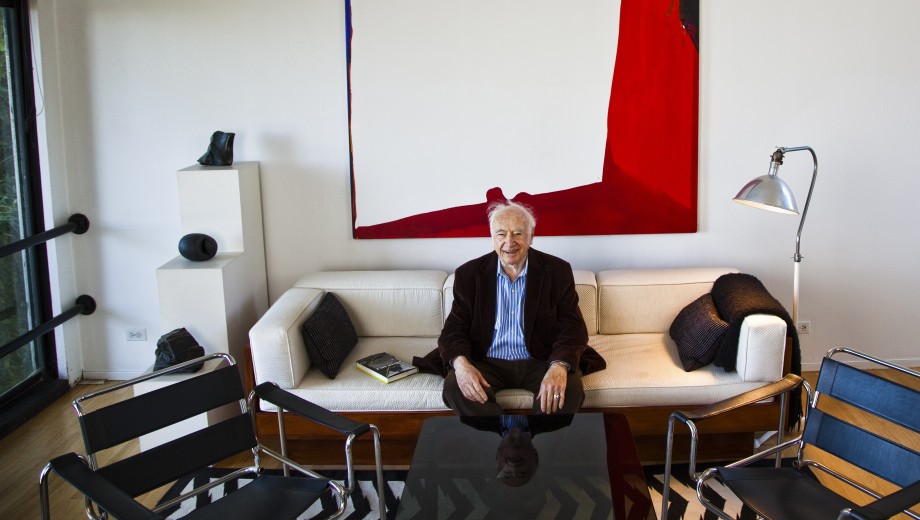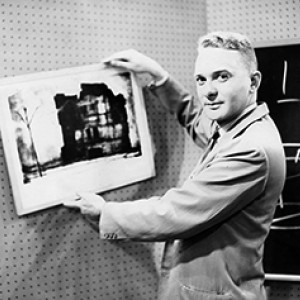Ask the 93-year-old art historian and curator Peter Selz what he is working on now, and his answers reveal the boundless energy and wide-ranging interests that have shaped his long career.
A trustee of the Neue Galerie in New York, he is planning to attend the museum’s upcoming board meeting in Vienna. A prolific author and critic, he is writing a long essay for a book about the American painter Arnold Mesches. In 2012 he co-organized two exhibitions at San Francisco’s nonprofit Meridian Gallery—one of artworks by beat-generation poets, another by the contemporary Irish painter Patrick Graham. And he serves on the acquisitions committee of the city’s de Young and Legion of Honor museums.
Officially, Selz retired to his modernist home in the Berkeley Hills when he became an emeritus professor of art history at the University of California, Berkeley, in 1988. But he has never stopped looking at, writing about, and delighting in art that he believes to be important, whether contemporary audiences have heard of the artist or not.
“I’ve always worked with artists who were not part of the mainstream,” he says. “I’ve always been, in a way, an outsider.”
Yet Selz became an insider who landed prestigious jobs. He organized groundbreaking shows as curator of modern painting and sculpture exhibitions at the Museum of Modern Art (MoMA) in New York from 1958 to 1965, and later became the founding director of the UC Berkeley Art Museum. Well before he studied art formally, family connections gave him a privileged entrée to the art world.
This year Selz also celebrated the publication of what he jovially calls his “semiauthorized biography,” Peter Selz: Sketches of a Life in Art, by Paul J. Karlstrom. The book begins with Selz’s boyhood in Germany, where his maternal grandfather, an art dealer, introduced him to Renaissance and baroque masterpieces in the museums and galleries of Munich.
Selz also developed an interest in contemporary painters—Wassily Kandinsky, Paul Klee, Max Beckmann, and others—whom the Nazis would denounce as “degenerate.” As a teenager he remembers seeing an informal display of their confiscated works at a Munich police station around 1935: “I was certainly moved by what I saw, and I thought this was pretty good art,” he says.
“I’ve always worked with artists who were not part of the mainstream,” says Selz.
From a Jewish family, Selz was barred from pursuing his education in Germany and at age 17, he took a boat to New York City, alone. On the eve of World War II he spent a year at Columbia University and supported himself by working at a brewery. Still hoping for an art career, he introduced himself to Alfred Stieglitz, a distant relative whose Madison Avenue gallery, An American Place, was a hub for modern artists and photographers. “He took me in hand,” says Selz, “and I learned a lot from him.”
Selz became a US citizen and served in the Army’s Office of Strategic Services during the war. In 1946, he took advantage of the GI Bill to attend the University of Chicago. “I never got a BA; you could go straight for an MA and on to a PhD at that time,” he recalls. “The three most important professors for me” were two respected art historians, Ulrich Middeldorf and Joshua Taylor, and Committee on Social Thought cofounder John U. Nef, whose economic history course Selz took before deciding to concentrate on art.
Middeldorf, an anti-Nazi German émigré and expert in Italian Renaissance sculpture, encouraged Selz to write a history of the German expressionist movement. For a doctoral student to focus broadly on art in its political and social context “was very unusual then, as it would be now,” says Selz, but “it was a marvelous thing for him to suggest.”
Taylor joined the department in the mid-1950s and would soon publish the popular primer Learning to Look: A Handbook for the Visual Arts. He was just two years older than Selz, but the Princeton-trained art historian “knew a lot more,” says Selz, and helped him complete one of the country’s first PhDs on twentieth-century art.
Selz’s dissertation became German Expressionist Painting, a book that remains in print more than 50 years later. “There’s really nothing else out there yet that quite matches that book,” says Reinhold Heller, an emeritus professor in Art History who also specializes in German art, citing the work’s “deep-seated scholarship, historical analysis, and visual acuity.”
 In Chicago, Selz immersed himself in the local art scene, forging close relationships with visual artists such as Leon Golub, AB’48—a practice he continued in New York and California. As a student, he helped organize a well-received show of contemporary Chicago art at the Renaissance Society. He also taught part time at the Institute of Design (also known as the New Bauhaus), “a marvelous place [and] the most progressive art school in the country.”
In Chicago, Selz immersed himself in the local art scene, forging close relationships with visual artists such as Leon Golub, AB’48—a practice he continued in New York and California. As a student, he helped organize a well-received show of contemporary Chicago art at the Renaissance Society. He also taught part time at the Institute of Design (also known as the New Bauhaus), “a marvelous place [and] the most progressive art school in the country.”
When the financially strapped Institute of Design was absorbed by the Illinois Institute of Technology in 1955, Selz happily accepted an offer from Pomona College to chair its art department and direct its museum. In California, he mounted imaginative exhibitions and kept up his New York connections. Those efforts and his Chicago training, Selz believes, led MoMA to hire him as curator of modern painting and sculpture exhibitions in 1958.
At MoMA, Selz was given the freedom to conceive and organize provocative new shows that advanced his reputation as a canon-challenging curator and critic. For the 1959 exhibition New Images of Man, he embraced outsider artists and works that celebrated the human figure at a time when abstract expressionism was most in vogue. For Homage to New York, another Selz show, the Swiss artist Jean Tinguely created a machine designed to burst into flames and self-destruct in the museum’s sculpture garden—a daring conceptual proposition for 1960. Selz also organized major exhibitions of works by Mark Rothko, Jean Dubuffet, Auguste Rodin, Max Beckmann, and Alberto Giacometti.
Moving back to California in the mid-1960s, Selz continued to make pioneering contributions as a curator, teacher, and writer. He organized the country’s first kinetic sculpture exhibition and served as project director for Christo and Jeanne-Claude’s outdoor installation Running Fence. To date, he has published more than 50 books and catalogs on modern art. Those accomplishments, Selz’s biographer writes, “have secured his position as an important presence and voice in his chosen field.”
In his so-called retirement, Selz champions artists who are politically and socially engaged and “art that matters” rather than works that sell well or draw crowds. He counts the contemporary artists William Kentridge, Anselm Kiefer, and Patrick Graham in this group—although he believes there is no longer a consensus about what makes a great artist or work of art.
Over time Selz has developed a definition that captures his strongest feelings about art and explains the choices he’s made over a remarkable career. “Good art,” he argues, “is a visual metaphor for significant human experience.”


